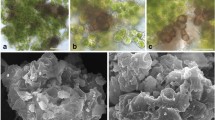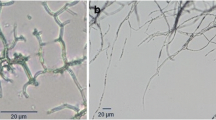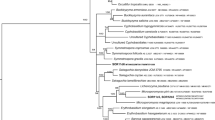Abstract
Black, rock inhabiting fungi (RIF) are polyextremotolerant, oligotrophic organisms which colonize bare rocks and are specialized to grow in niches precluded to other microorganisms in the harshest environments. In many cases RIF share this environment with green algae and cyanobacteria forming subaerial biofilms; some of them have also been found to be associated with lichen thalli. The RIF genus Lichenothelia is of particular interest because it includes lichen parasites and species which are loosely associated with algae or grow independently on rocks. Here, in vitro culture experiments studied the development of three Lichenothelia species when co-cultured with two different lichen photobionts on growth media differing in nutrient content. The growth rates of these fungi were statistically evaluated and the structure of the mixed cultures was analyzed by light and scanning electron microscopy. The results show that the presence of algae neither influence the growth rate of fungi nor the formation of any lichen-like structure; tight contacts between the hyphae and the algal cells were also not detected. Since multiple trials were carried out on well characterized species of microcolonial fungi and the methodological procedures were established, standardized and coupled with morphological analyses, this approach proves suitable for future investigations on fungal-algal interactions in other systems.





Similar content being viewed by others
References
Ahmadjian V (1973) Methods of isolation and culturing lichen symbiont and thalli. Ahmadjian V and Hale M E The Lichens. Academic Press, New York, In, pp 653–660
Ahmadjian V, Jacobs JB (1981) Relationship between fungus and alga in the lichen Cladonia cristatella Tuck. Nature 289:169–172
Ahmadjian V, Jacob JB, Russell LA (1978) Scanning electron microscope study of early lichen symbiosis. Science 200:1062–1064
Bischoff HW, Bold HC (1963) Phycological studies IV. Some soil algae from enchanted rock and related algal species. Univ Texas Publ 6318:1–95
Bold HC (1949) The morphology of Chlamydomonas chlamydogama sp. nov. Bull Torrey Bot Club 76:101–108
Brunauer G, Blaha J, Hager A, Turk R, Stocker-Wörgötter E, Grube M (2007) An isolated lichenicolous fungus forms lichenoid structures when co-cultured with various coccoid algae. Symbiosis 44:127–136
Culberson CF, Ahmadjian V (1980) Artificial reestablishment of lichens. II Secondary products of resynthesized Cladonia cristatella and Lecanora chrysoleuca. Mycologia 72:90–109
Dadachova E, Bryan RA, Huang X, Moadel T, Schweitzer AD, Aisen P, Nosanchuk JD, Casadevall A (2007) Ionizing radiation changes the electronic properties of melanin and enhances the growth of melanized fungi. PLoS One 2(5):e457
Geiser DM, Gueidan C, Miadlikowska J, Lutzoni F, Kauff F, Hofstetter V, Fraker E, Schoch CL, Tibell L, Untereiner WA, Aptroot A (2006) Eurotiomycetes: Eurotiomycetidae and Chaetothyriomycetidae. Mycologia 98:1053–1064
Gorbushina AA, Beck A, Schulte A (2005) Microcolonial rock inhabiting fungi and lichen photobionts: evidence for mutualistic interactions. Mycol Res 109:1288–1296
Gostincar C, Grube M, Gunde-Cimerman N (2011) Evolution of fungal pathogens in domestic environments? Fungal Biol 115:1008–1018
Gostincar C, Muggia L, Grube M (2012) Polyextremotolerant black fungi: oligotrophism, adaptive potential, and a link to lichen symbioses. Front Microbiol 3:390
Gueidan C, Roux C, Lutzoni F (2007) Using a multigene analysis to assess generic delineation and character evolution in the Verrucariaceae (Eurotiomycetes, Ascomycota). Mycol Res 111:1147–1170
Gueidan C, Ruibal C, de Hoog GS, Schneider H (2011) Rock-inhabiting fungi originated during periods of dry climate in the late Devonian and middle Triassic. Fungal Biol 115:987–996
Hawksworth DL (1981) Lichenothelia, a new genus for the Microthelia aterrima group. The Lichenologist 13:141–153
Hessen H (1987) Lichenothelia, a genus of microfungi on rocks. In Peveling E, ed. Progress and problems in lichenology in the eighties. Bibl Lichenol 25:257–293
Hom EFY, Murray AW (2014) Plant-fungal ecology. Niche engineering demonstrates a latent capacity for fungal-algal mutualism Science 345:94–98
Hyde KD, Jones EG, Liu JK et al (2013) Families of Dothideomycetes. Fungal Divers 63:1–313
Isola D, Selbmann L, de Hoog GS, Fenice M, Onofri S, Prenafeta-Boldù FX, Zucconi L (2013) Isolation and screening of black fungi as degraders of volatile aromatic hydrocarbons. Mycopathologia 175:369–379
Joneson S, Lutzoni F (2009) Compatibility and thigmotropism in the lichen symbiosis: a reappraisal. Symbiosis 47:109–115
Joneson S, Armaleo D, Lutzoni F (2011) Fungal and algal gene expression in early developmental stages of lichen-symbiosis. Mycologia 103:291–306
Kocourková J, Knudsen K (2008) Four new lichenicolous fungi from North America. Evansia 25:62–64
Kocourková J, Knudsen K (2011) Lichenological notes 2: Lichenothelia convexa, a poorly known rock-inhabiting and lichenicolous fungus. Mycotaxon 115:345–351
Kuhlman KR, Venkat P, La Duc MT, Kuhlman GM, McKay CP (2008) Evidence of a microbial community associated with rock varnish at Yungay, Atacama Desert, Chile. J Geophys Res: Biogeosciences 113:G04022
Meeßen J, Ott S (2013) Recognition mechanisms during the pre-contact state of lichens: I. Mycobiont-photobiont interactions of the mycobiont of Fulgensia bracteata. Symbiosis 59:121–130
Muggia L, Grube M, Tretiach M (2008) Genetic diversity and photobiont associations in selected taxa of the Tephromela atra group (Lecanorales, lichenized Ascomycota). Mycol Prog 7:147–160
Muggia L, Baloch E, Stabentheiner E, Grube M, Wedin M (2011) Photobiont association and genetic diversity of the optionally lichenized fungus Schizoxylon albescens. FEMS Microbiol Ecol 75:255–272
Muggia L, Gueidan C, Knudsen K, Perlmutter G, Grube M (2013) The lichen connection of black fungi. Mycopathologia 175:523–535
Muggia L, Kocourkova J, Knudsen K (2015) Disentangling the complex of Lichenothelia species from rock communities in the desert. Mycologia 107:1233–1253
Muggia L, Fernàndez-Brime S, Grube M, Wedin M (2016) Schizoxylon as an experimental model for studying interkingdom symbiosis. FEMS Microbiol Ecol 92:fiw165
Nai C, Wonga HY, Pannenbecker A, Broughton WJ, Benoit I, de Vries RP, Gueidan C, Gorbushina AA (2013) Nutritional physiology of a rock-inhabiting, model microcolonial fungus from an ancestral lineage of the Chaetothyriales (ascomycetes). Fungal Genet Biol 56:54–66
Onofri S, de la Torre R, de Vera J, Ott S, Zucconi L, Selbmann L, Scalzi G, Venkateswaran KJ, Rabbow E, Sánchez Iñigo FJ, Horneck G (2012) Survival of rock-colonizing organisms after 1.5 years in outer space. Astrobiology 12:508–516
Pacelli C, Bryan R A, Onofri S, Selbmann L, Shuryak I, Dadachova E (2017) Melanin is effective in protecting fast and slow growing fungi from various types of ionizing radiation. Environ Microbiol. doi:10.1111/1462-2920.13681
Palmer RJ, Friedman EI (1988) Incorporation of inorganic carbon by Antarctic cryptoendolithic fungi. Polarforschung 58:189–191
Qi B, Moe WM, Kinney KA (2002) Biodegradation of volatile organic compounds by five fungal species. Appl Microbiol Biotechnol 58:684–689
Sage D (2008) Biomedical Imaging Group (BIG) Ecole Polytechnique Fédérale de Lausanne (EPFL) http:/bigwww.epfl.ch/sage/soft/colorsegmentation/. Accessed Oct 2016
Selbmann L, de Hoog GS, Mazzaglia A, Friedmann EI, Onofri S (2005) Fungi at the edge of life: cryptoendolithic black fungi from Antarctic desert. Stud Mycol 51:1–32
Selbmann L, de Hoog GS, Zucconi L, Isola D, Ruisi S, Gerrits van den Ende AHG, Ruibal C, De Leo F, Urzì C, Onofri S (2008) Drought meets acid: three new genera in a dothidealean clade of extremotolerant fungi. Stud Mycol 61:1–20
Selbmann L, Isola D, Egidi E, Zucconi L, Gueidan C, de Hoog GS, Onofri S (2014) Mountain tips as reservoirs for new rock-fungal entities: Saxomyces gen. Nov. and four new species from the alps. Fun Div 65:167–182
Sterflinger K (1998) Temperature and NaCl tolerance of rock-inhabiting meristematic fungi. Anton Van Lee 74:271–281
Stocker-Wörgötter E, Türk R (1991) Artificial resynthesis of thalli of the cyanobacterial lichen Peltigera praetextata under laboratory conditions. Lichenologist 23:127–138
Thüs H, Muggia L, Pérez-Ortega S et al (2011) Revisiting photobiont diversity in the lichen family Verrucariaceae (Ascomycota). Eur J Phycol 46:399–415
Turian G (1977) Coniosporium aeroalgicolum sp. nov. – a dematiceous fungus living in balanced parasitism with aerial algae. Bull soc Bot Suisse 87:19–24
Valadbeigi T, Schultz M, Von Brackel W (2016) Two new species of Lichenothelia (Lichenotheliaceae) from Iran. Lichenologist 48:191–199
Waschuk SA, Bezerra AG, Shi L, Brown LS (2005) Leptosphaeria rhodopsin: bacteriorhodopsin-like proton pump from a eukaryote. Proc Natl Acad Sci U S A 102:6879–6883
Wierzchos J, Cámara B, De Los RA, Davila AF, Sánchez Almazo IM, Artieda O, Ascaso C (2011) Microbial colonization of Ca-sulfate crusts in the hyperarid core of the Atacama Desert: implications for the search for life on Mars. Geobiology 9:44–60
Wijayawardene NN, Crous PW, Kirk PM et al (2014) Naming and outline of Dothideomycetes–2014 including proposals for the protection or suppression of generic names. Fun Div 69:1–55
Yoshimura I, Kurokawa T (1993) Development of lichen thalli in vitro. Bryologist 96:412–421
Acknowledgements
This research was supported by the project FRA-2014 (Finanziamenti di Ateneo per progetti di Ricerca scientifica) assigned to LM by the University of Trieste. Francesca Vita is thanked for the support in the SEM analyses; Martin Grube and Lorenzo Fortuna are thanked for the constructive discussions. The Italian National Antarctic Museum “Felice Ippolito” is kindly acknowledged for funding CCFEE (Culture Collection of Fungi from Extreme Environments).
Author information
Authors and Affiliations
Corresponding author
Rights and permissions
About this article
Cite this article
Ametrano, C.G., Selbmann, L. & Muggia, L. A standardized approach for co-culturing dothidealean rock-inhabiting fungi and lichen photobionts in vitro. Symbiosis 73, 35–44 (2017). https://doi.org/10.1007/s13199-017-0479-2
Received:
Accepted:
Published:
Issue Date:
DOI: https://doi.org/10.1007/s13199-017-0479-2




